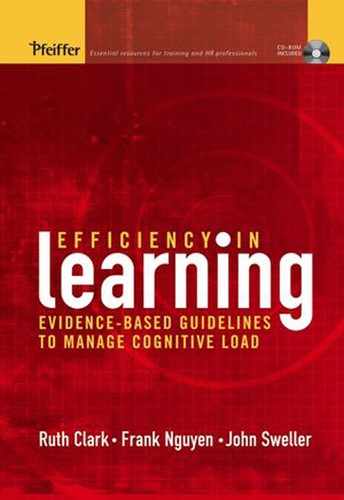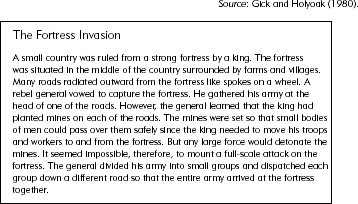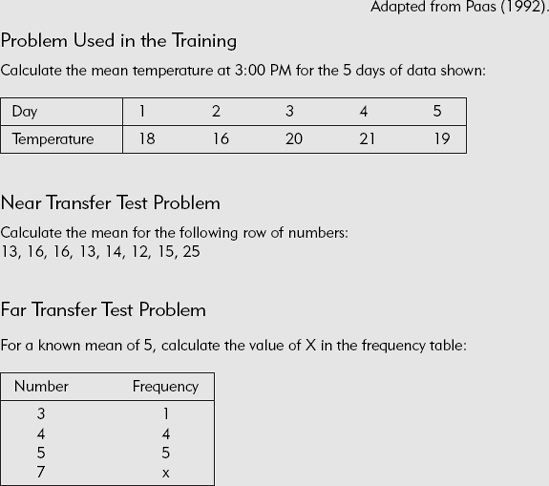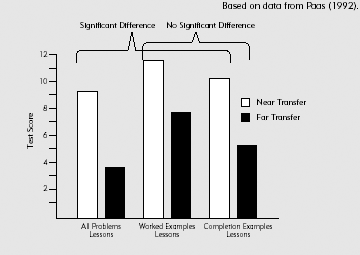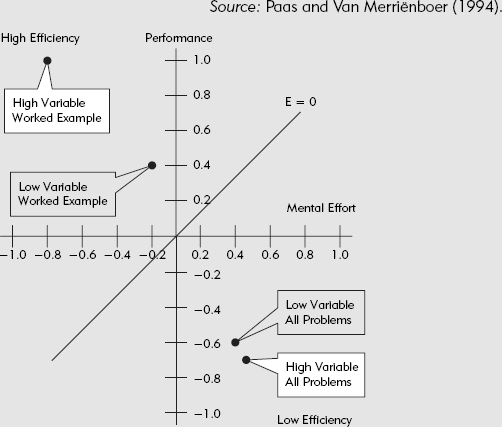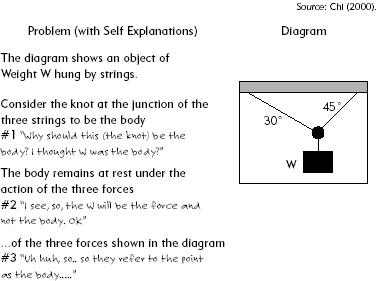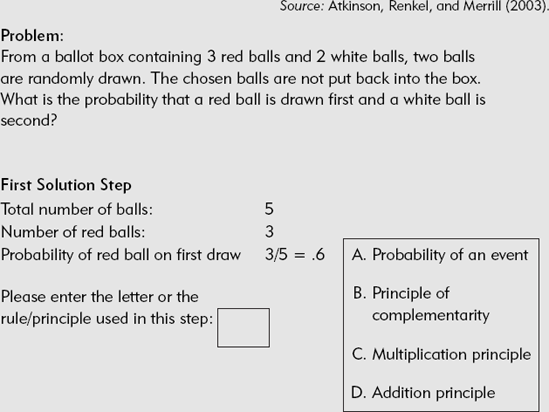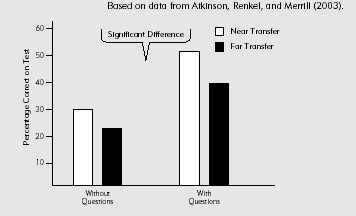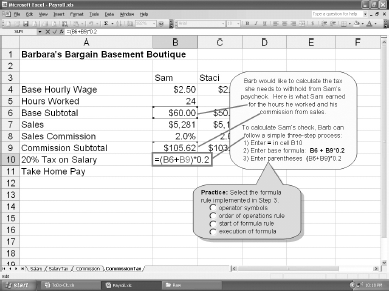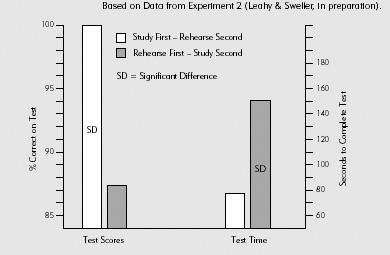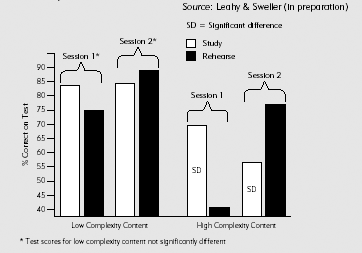
In Part II we focused on ways you can keep cognitive load low. Why is elimination of extraneous mental load so important? Recall from Chapter 2 that learning involves the formation of new schemas that are stored in long-term memory. The difference between an expert and a novice in any domain is the expert's larger number and better organization of schemas. Learners form new schemas in working memory by integrating incoming information with prior knowledge. After the learner has built a new schema, he still must invest a lot of mental effort when initially using it. All of these activities require working memory resources. By minimizing extraneous sources of cognitive load, you free up working memory for learning.
Instruction has two main goals. The first goal is to help learners form new schemas. The second goal is to help them automate those new schemas in ways that lead to efficient and effective job performance. Both of these activities impose a load on working memory that we call germane load. By reducing extraneous load, we free up working memory capacity for germane load.
In this chapter we review four guidelines that will add load in the service of fostering learning. The first two guidelines help learners build schemas, and the second two guidelines help them automate new schemas.
At this point we pick up the story of worked examples from where we left off in the last chapter. In Chapter 8 we saw that, for novice learners, studying worked examples-practice pairs resulted in more efficient learning than working practice problems. We also saw that completion examples, partial worked examples that the learner finishes, encourage learners to actively study the worked examples. In fact, an ideal approach is to transition from full worked examples through a series of increasingly faded completion examples to full practice problems. This gradual shift of mental work takes advantage of the growth of expertise as the learner progresses through the instructional program.
How might you solve this problem?
Suppose you are a doctor faced with a patient who has a malignant tumor in his stomach. It is impossible to operate on the patient, but unless the tumor is destroyed, the patient will die. There is a kind of ray that at a sufficiently high intensity can destroy the tumor. Unfortunately, at this intensity, the healthy tissue that the rays pass through on the way to the tumor will also be destroyed. At lower intensities, the rays are harmless to healthy tissue but will not affect the tumor either. How can the rays be used to destroy the tumor without injuring the healthy tissue?
Jot down a few ideas of how you might tackle the tumor problem. Then read the fortress story in Figure 9.1. Does the fortress story hold a clue you can use to solve the tumor problem? If you had read the fortress story first, would it have helped you solve the tumor problem? The solution to the tumor problem is to use weak rays from multiple locations around the body but all passing through the site of the tumor. The common principle linking these two stories is a convergence principle. Both fortress and tumor problems are solved by aligning many small components to converge onto a central target. Being able to apply a principle learned in one setting to a different setting is called far transfer of learning.
Would you be surprised that in a research study only 30 percent of individuals who read the fortress story were able to apply the convergence principle to the tumor problem (Gick & Holyoak, 1980)? The context of the tumor problem is so different from that of the fortress problem that most people simply do not see the relationship. As a result, most people do not abstract the convergence principle from the fortress story.
The transfer failure demonstrated in the tumor problem experiment is a common occurrence. Haskell (2001) begins his book on transfer with the discouraging observation: "Despite the importance of transfer of learning, research findings over the past nine decades clearly show that as individuals, and as educational institutions, we have failed to achieve transfer of learning on any significant level" (p. xiii). Transfer failure means you may have built some skills during the training. The learners may even score high on your test. But later, back on the job, they are unable to apply what they've learned.
In the training world, we can distinguish between instructional goals that are relatively near transfer and those that are more far transfer. Near transfer tasks are activities that are completed more or less the same way each time. Accessing your email and processing a routine customer order are two common examples. Near transfer tasks are based on procedures that are done the same way each time they are performed. In contrast, far transfer tasks require the performer to adapt her skills to each new situation. Selling a new product or designing a web page are two examples. Because no two sales or websites are identical, the worker must adapt her skills. Of course, near and far transfer tasks are not really two separate categories but represent a continuum. When you are developing training programs, you will have some near transfer outcomes, some far transfer outcomes, and some that are a combination of both.
Recall the fortress and the tumor problems. One has a medical setting and the other a military context. Their surface features—what we call the "cover story" are quite different. That is why most people don't apply the fortress solution to solve the tumor problem. The context of the tumor problem is too different. However, when you look beneath the cover story you find a common solution principle. The convergence principle makes up the structural feature the two stories have in common. The challenge to training far transfer tasks is to help learners see beyond the cover story of the problem or task they are facing and identify the relevant principles.
In order to succeed at far transfer tasks, workers must be able to represent a problem in terms of its structural features. To do so they need a schema that is flexible enough to transfer to many situations. Instructional methods that help learners build flexible schemas will impose additional cognitive load. Unlike extraneous load discussed in earlier chapters, this type of load is productive. Therefore, we call it germane load.
Gick and Holyoak (1980) looked for some effective ways to help learners solve the tumor problem. As we discussed, just reading the fortress problem alone was not sufficient. However, they found that asking learners to study two different problems with different cover stories but the same structure helped learners build a more transferable schema. Gick and Holyoak asked learners to read the fortress story and then a story about a fire on an oil rig that was put out by many small hoses aimed toward the middle of the fire. After reading, learners either drew a picture or wrote a summary of the common features of the solutions. This activity focused attention on the convergence principle underlying the two stories and helped learners build a more flexible schema. These learners had much greater success solving the tumor problem because they had abstracted the convergence principle from two examples. Experts in all domains excel as a result of many schemas that incorporate knowledge of principles and knowledge of when to apply those principles. Most of these schemas have evolved from experience solving many problems over a long time period and, as a result, abstracting schemas for future use.
To accelerate this abstraction process, provide learners several examples or problems with similar structural features but different cover stories. We call these kinds of examples varied context examples. At the same time, encourage learners to focus on the structure, not on the cover story.
For example, in our Excel demonstration lesson on the CD, our goal is to enable workers to construct formulas for a variety of calculations. We built examples using data from a hypothetical small business—Barb's Bargain Basement. Learners saw examples involving calculation of profit per month, profit per employee, employee base pay, and employee net pay after commissions and taxes. All this diversity in examples and practice exercises will help learners apply formulas to whatever unique work situations they face. In other words, they will be able to successfully transfer what they have learned to their own applications.
The research we have reviewed supporting Guideline 21 suggests that when learners must adapt new knowledge and skills to problems or situations that differ from those presented in training, they need to build a flexible schema. Schemas that can adapt to far transfer outcomes are based on domain-specific principles such as the convergence principle illustrated with the tumor problem. To encourage learners to build principle-based schemas, provide a variety of instances in the form of worked examples and practice problems that vary the cover stories but incorporate the structural features. Through engagement with varied context examples and practice, learners formulate schemas that are principle-based. The result is learners who know not only the procedures but also the conditions under which those procedures apply.
However, the deeper processing required to abstract principles from diverse examples imposes an additional load on working memory. Using worked examples helps offset this load. Psychologically, a method that imposes germane cognitive load (diversity in examples and practice) is effective because extraneous cognitive load is minimized (through worked examples rather than all practice).
The research supporting Guideline 21 tells us that:
Examples and practice with diverse contexts lead to better far transfer learning than examples that are similar.
Examples and practice with diverse contexts add more cognitive load than examples that are similar.
Worked examples help reduce cognitive load.
When faced with far transfer instructional goals, you should provide a series of diverse context examples to add germane load and make them worked examples to reduce extraneous load.
We've seen in this chapter and in Chapter 8 that worked examples or completion examples are an efficient way to help learners build new mental models. However, often learners do not process examples very deeply. In the case of full worked examples, they may skip them altogether. In the case of completion examples, they may finish the example by filling in the steps but not pay much attention to the principles underlying the examples. As a result of shallow processing of the example, learning suffers. One way to promote better learning from worked examples is to encourage your learners to make effective self-explanations.
A self-explanation is a mental dialog that learners have when studying a worked example that helps them understand the example and build a schema from it. Chi and her colleagues (1989) reported that students who generated more self-explanations of examples learned more than students who generated fewer self-explanations. They found that, when studying physics examples, better learners generated on average 15.5 self-explanations per example, compared to 2.75 from poorer learners. A good self-explanation leads to an understanding that builds a complete and accurate mental model.
In the sample self-explanation of a physics problem shown in Figure 9.5, you see a physics worked example (diagram and bold text) and (in italics) the learner's self-explanations. Note that in the first statement, the learner identifies his confusion between the mass (W) and the body (the knot). Misunderstandings often arise from a conflict between what is read in the instructional materials and one's existing schema. In the process of the self-explanation, this learner identifies the conflict and revises his conception of mass and body. Good self-explanations either identify and correct misconceptions or they elaborate on the ideas through inferences. The positive effects of self-explanations have been seen in a variety of content domains and in ages ranging from five years to college students.
Many learners do not self-explain. Or when they do, their explanations are shallow. For example, they might just repeat the words in the example. Good self-explanations involve deep processing of the material. Researchers have asked learners to talk aloud while self-explaining and have analyzed the number and type of self-explanations given. They then correlated the patterns of self-explanations with learning. They found three main types of productive self-explanations: (1) monitor and correct; (2) try and check; and (3) make inferences by associating the examples with underlying principles or prior knowledge.
In monitor and correct self-explanations, learners identify elements of the worked example they don't understand and strive to resolve discrepancies. The self-explanations illustrated in Figure 9.5 are of the monitor and correct type. The try and check self-explanation involves reading a worked example, covering up the solution steps, and trying to work it. Then the learner checks her steps and answer against the example. Inferencing involves making new connections, either between separate sentences in the worked example or between the worked example and learner prior knowledge.
The research reviewed in Guideline 21 recommends that you promote deeper processing of worked examples by:
Training learners to self-explain worked examples in small classroom sessions.
Demonstrate several effective self-explanations of examples.
Discuss the demonstrations.
Ask students to practice making self-explanations.
Use peer and instructor feedback to improve self-explanations.
Periodically remind learners to self-explain during training.
Using faded completion examples that will require learners to self-explain the portions they fill in.
Adding questions to the worked-out portions of completion examples that require learners to understand principles behind the worked examples. (See Figure 9.8 for an example of a self-explanation question in an Excel e-lesson.)
Of course, since in the garden grill design experiment, the participants were explaining their ideas to another person, by definition this is not a self-explanation. We wonder whether similar results would be achieved if participants simply had a self-dialog—like the self-explanations we have discussed above. Or would improved designs be achieved if students responded to a virtual partner who asked questions like the ones used in this study? We will look to future research to shed light on these questions.
In the previous sections of this chapter, we have considered techniques to assist learners to use their cognitive resources in constructing schemas. Of course, learning is more than constructing schemas. Those schemas need to be automated as well so that working memory resources are freed to allow the construction of more complex schemas. In another example of germane cognitive load, the remainder of the chapter considers techniques that assist learners to use their cognitive resources to automate knowledge and skills.
There are occasions when a performance aid is not practical, such as when work tasks require fast and accurate responses. Landing an airplane is one example. In addition, complex tasks rely on a number of subtasks. Attempting to perform these complex tasks while at the same time allocating mental capacity to performing the subtasks will overload working memory. In order to perform complex tasks, those prerequisite skills must be available to memory in a way that does not overload working memory. These situations require that knowledge and skills become automated. Under Guideline 23, we define automaticity and discuss when and how to build automaticity in your learners.
As you read this paragraph, you are using a number of automated perceptual and cognitive skills. When you drive a car, you are using automated perceptual and motor skills. In fact, all complex tasks can only be performed effectively because a myriad of underlying subtasks have been automated. When knowledge or skills become automated, they are coded into long-term memory and can be exercised with minimal or no resources from working memory. That is why automaticity offers an internal bypass of working memory. Since automated skills require no or minimal working memory resources, the cognitive system is freed up for multitasking. For example, as I type this sentence I concentrate on writing a series of words that make sense and that contribute to the point of the paragraph. I don't need to spend any conscious effort locating and striking the computer keys, which would absorb working memory resources that would not be available for composing text.
When learning new skills you begin by slowly building a schema in long-term memory. Initially your task performance is slow and inaccurate. Over time, with practice and feedback, performance becomes more accurate. With even more time and practice, the schemas eventually automate. At that point performance is both accurate and very fast.
There is no magic path to automaticity. Skills become automatic only after many, many practice sessions. While the number of iterations needed for any specific skill may vary somewhat, Shiffrin and Schneider (1977) found that over two thousand practice sessions were required to automate a letter-matching task. Your current reading and math skills grew out of hundreds of drill and practice sessions you had in school. If you are a touch typist, you learned by devoting hours to typing drills. Automaticity can be achieved in training settings that allocate time for a great deal of drill and practice. More often, however, automaticity is actually achieved on the job as a result of repetitive task performance.
While achieving automaticity can take a long time, the payoff can be dramatic. Kotovsky, Hayes, and Simon (1985) found that when a problem was presented in a form that permitted subjects to use automated information, on average, it was solved sixteen times faster than a structurally identical problem that required the use of non-automated information. Without automation, many tasks become very difficult or even impossible.
Workers will need to automate knowledge and skills when learning tasks that require a response that is both very fast and very accurate. For example, train engineers must immediately recognize a track signal and take appropriate action. There is no time to access a signal reference aid. Workers will also need to automate knowledge and skills when the job requires complex responses that rely on multiple subskills that must be coordinated. In other words, when the job requires multitasking, automation of underlying skills is essential.
Repetitive practice needed to build automaticity will impose cognitive load. However, this type of load is called germane load because it is relevant to the instructional goal. Cognitive load theory recommends the following:
Help learners build a new schema in long-term memory with explanations, worked examples, completion examples, and practice with feedback. Your learners have achieved an initial stage of learning when they can perform tasks accurately but not necessarily quickly. At this initial stage of learning, task performance is effortful and demands working memory resources.
Help learners automate these skills by giving learners many opportunities to rehearse new knowledge and skills. This type of repetitive rehearsal is often called drill and practice. Automaticity can be achieved through hands-on practice exercises or with mental rehearsal, as summarized under Guideline 24.
In this chapter we address two phases of learning. During the early stages of learning, help learners form robust mental models by encouraging them to engage in productive self-explanations of varied context faded worked examples. However, once the mental models are formed, automaticity is best achieved through practice performing the task and/or solving problems. One form of practice leading to automaticity is mental rehearsal.
Cooper, Tindall-Ford, Chandler, and Sweller (2001) define mental rehearsal as "the introspective or covert rehearsal that takes place within the individual who thinks through the performance of an activity" (p. 68). Mental rehearsal could involve imagining someone else performing while you observe or imagining doing a task yourself. For example, an Olympic diver is standing at the end of the high diving board with his eyes closed. He is mentally imagining the body moves he will make as he executes the dive. In fact, the interest in the use of imagery that emerged in sports psychology in the 1960s and 1970s continues to be a focus of research today (Etneir & Landers, 1996; Romero & Silvertri, 1990). For our purposes we will look at the effects of mental rehearsal on cognitive tasks such as constructing a spreadsheet formula, plotting points on a graph, or calculating basic statistics.
Mentally rehearsing the steps to perform a task or solve a problem requires free capacity in working memory. Therefore learners should not rehearse while they are forming their schemas, since both activities would overload working memory. Instead, assign mental rehearsal to help build automaticity after learners have had a chance to form a mental model. In the next section we summarize research showing that asking learners to mentally rehearse a worked example is more effective than asking them to study that example only after they have built a basic mental model of the task.
The experiments supporting Guideline 24 tell us that:
Mental rehearsal is an effective mechanism for automating new knowledge and skills.
For skills of high complexity, help learners build a basic schema first by studying worked and completion examples.
For skills of high complexity, once the basic schemas are formed, learners can automate them through mental rehearsal of the steps.
For skills of low complexity that do not demand as much working memory resources, the sequence of studying and mental rehearsal does not matter.
There are solid research and psychological reasons to recommend that you should:
Provide learners with varied context examples to encourage building of more complex mental models that will support far transfer.
Format diverse examples as faded completion examples to compensate for extra germane load.
Promote productive self-explanations of examples by training learners to self-explain or by requiring them to respond to questions that focus their attention on the underlying principles.
Ask learners to mentally rehearse steps involved in a task once a basic schema is developed. Mental rehearsal is most effective when the instructional goal involves content of moderate to high complexity.
Chapter 9. Put Working Memory to Work with Germane Load. Following a description of germane cognitive load, John discusses variable worked examples, self-explanations, and mental rehearsal techniques.
The asynchronous Load-Managed Excel Web-Based Lesson as well as the synchronous Virtual Classroom Example illustrate the use of:
Diverse contexts in examples and practice exercises for Excel formula construction.
Instructor promotion of processing of examples in the virtual classroom by asking learners to state the rules governing formulas as they review examples.
Throughout this book we have provided a number of evidence-based techniques that reduce extraneous cognitive load and/or increase germane cognitive load. We have emphasized that these techniques are most relevant when the content is complex and when the learners are relatively novice.
In Part IV, we will look at ways to adjust instruction as learners gain more expertise. Research we will review shows that, as learners gain expertise, many of the cognitive load techniques we have presented thus far not only do not help learners, but in fact they hinder their learning! Instructional scientists call this phenomena the expertise reversal effect. In the next chapter you will learn how to accommodate individual differences among learners with greater and lesser amounts of prior experience.
